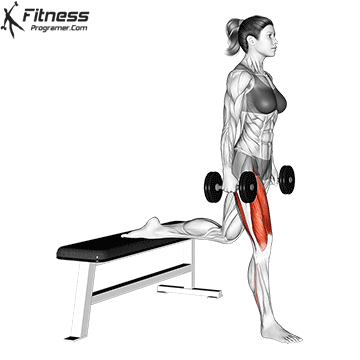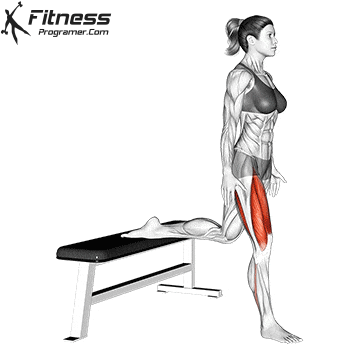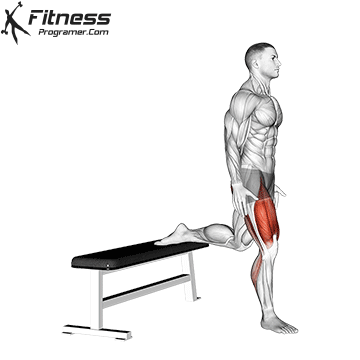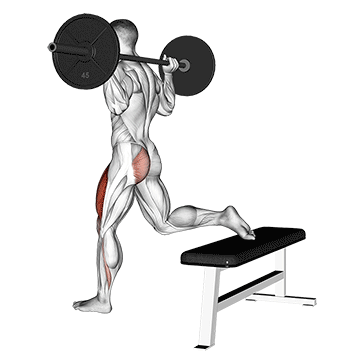Overview
The dumbbell Bulgarian split squat is a unilateral lower-body exercise where one foot is placed on an elevated surface while the front leg performs a squat motion. Holding dumbbells adds resistance, increasing muscular activation and stability demands. It places a strong emphasis on the quads, glutes, and hamstrings, while also engaging the core for stability. It is commonly used in strength training, athletic conditioning, and rehabilitation programs.
How to Perform the Dumbbell Bulgarian Split Squat

Step 1: Setup and Positioning
-
Stand about two feet in front of a bench or step, holding a dumbbell in each hand at your sides.
-
Place your rear foot on the bench with the top of your foot resting on it.
-
Keep your front foot planted firmly, with your toes pointing forward and your stance hip-width apart.
Step 2: Execution
-
Engage your core and keep your chest upright.
-
Lower your back knee toward the ground while keeping your front knee in line with your toes.
-
Descend until your front thigh is parallel to the ground or slightly below, ensuring your knee does not go past your toes.
-
Push through the heel of your front foot to return to the starting position.
-
Perform 8 to 12 reps per leg, then switch sides.
Tips for Proper Form
-
Maintain an upright torso to avoid excessive forward leaning.
-
Keep your front knee aligned with your toes to prevent strain.
-
Engage your core for better balance and stability.
-
Use controlled movements, avoiding bouncing at the bottom.
-
Start with bodyweight Bulgarian split squats if you are new to the movement before progressing to dumbbells.
Common Mistakes to Avoid
-
Placing the back foot too high or too low, which can limit mobility and stability.
-
Leaning forward excessively, which reduces quad activation and increases stress on the lower back.
-
Letting the front knee cave inward, leading to improper alignment and potential injury.
-
Using momentum instead of controlled movement, decreasing the effectiveness of the exercise.
-
Choosing weights that are too heavy, which can compromise form and reduce the range of motion.
Benefits of the Dumbbell Bulgarian Split Squat
1. Strengthens lower body muscles:
The unilateral nature of the exercise targets each leg individually, leading to better muscle activation and development. The quadriceps, hamstrings, glutes, and stabilizer muscles work together, resulting in increased strength and improved muscular balance.
2. Corrects Muscle Imbalances:
Many individuals have differences in strength and muscle development between their left and right legs. The dumbbell Bulgarian split squat helps address these imbalances by isolating each leg, promoting symmetrical strength and reducing the risk of injury.
3. Improves stability and balance:
Since this is a unilateral exercise, more stabilizer muscles engage to maintain balance and control. Improved proprioception and coordination enhance overall stability, benefiting functional movements and sports performance.
4. Enhances core activation:
Maintaining proper form during this exercise requires significant core engagement to stabilize the torso. The abdominals, obliques, and lower back work together to support the spine, contributing to overall core strength and improved posture.
5. Boosts Functional Strength:
The unilateral nature of the exercise mimics movements in daily activities and sports that often require single-leg strength and stability, such as walking, running, and jumping. By training with unilateral exercises like the dumbbell Bulgarian split squat, you can enhance your functional strength, making everyday movements and athletic activities more efficient and controlled.
6. Increases Flexibility and Mobility
This exercise stretches the hip flexors while simultaneously strengthening the lower body, promoting better mobility and range of motion.
7. Supports Cardiovascular Health
Performing the dumbbell Bulgarian split squat with higher intensity or in a circuit-style workout can elevate your heart rate and increase oxygen consumption. This leads to greater metabolic demand, aiding in calorie burn and supporting weight management goals.
8. Enhances Muscular Endurance
By incorporating this exercise into your routine, you can improve lower body muscular endurance, allowing you to sustain physical activity for longer durations without fatigue. Enhanced muscular endurance can also benefit cardiovascular performance during activities that involve continuous lower body exertion.
9. Offers Versatility and Convenience
The dumbbell Bulgarian split squat requires minimal equipment—a pair of dumbbells and an elevated surface—making it a versatile option for home or gym workouts. Additionally, it can be easily modified by adjusting weight, range of motion, or tempo to suit different fitness levels and goals.
How to Incorporate Into Your Routine
-
For Strength: Perform 3 to 4 sets of 6 to 8 reps per leg, using heavier dumbbells.
-
For Muscle Growth: Perform 3 to 4 sets of 8 to 12 reps per leg, focusing on slow and controlled movements.
-
For Endurance and Stability: Perform 3 sets of 12 to 15 reps per leg, using moderate weight.
-
Pair With: Romanian deadlifts, lunges, step-ups, and squats for a well-rounded leg workout.
Muscles Worked




